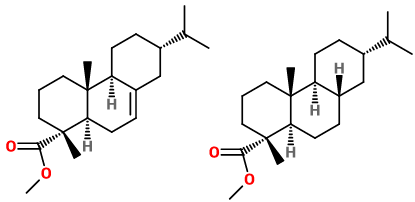Hercolyn®
Synthétique
Solvents > Dry Woods

Crédits photo: ScenTree SAS
Other names :
Methyl ester of hydrogenated rosin
Volatility :
Base
Uses in perfumery :
Carrier and fixative in fragrance compounds; component in chewing gum base to adjust hardness, plasticity, & chew characteristics; cosmetics, depilatory waxes, & other personal care products; adhesives, inks, floor tile, vinyl plastics, rubber compositions, & related applications.
Natural availability :
Hercolyn® can be obtained from Abietic acid, which is itself a distillation waste of turpentine EO. It is therefore possible to find this molecule in its natural state. however, its synthetic form is generally prioritized for economical reasons.
Year of discovery :
Data not available.
Other comments :
Hercolyn® is a mixture of two diterpenoid molecules, i.e. they contain 20 carbon atoms in their structures. This leads to a very, very low odor.
Price Range :
Data not available.
Stability :
Stable

Crédits photo: ScenTree SAS
- Molecular formula :
- Donnée indisponible.
- Molecular Weight :
- 321 g/mol
- Density :
- 1,02 @25°C
- Flash Point :
- 177°C (351°F)
- Fusion Point :
- Donnée indisponible.
- Appearance :
- Colorless visquous liquid
- Log P :
- Donnée indisponible,
- Boiling Point :
- 360 - 364°C
- Detection Threshold :
- Donnée indisponible.
Synthesis route :
Hercolyn® is a mixture of two molecules obtained from abietic acid, which is itself a distillation residue of turpentine EO, just like Abalyn®
Synthesis precursor :
Hercolyn® is not a synthesis precursor of any other substance with olfactory interest.
Isomerism :
Data not available.
- EINECS number :
- 232-476-2
- FEMA number :
- Donnée indisponible.
- JECFA number :
- Donnée indisponible.
- FLAVIS number :
- Donnée indisponible.
- Allergens :
- This ingredient does not contain any allergen.
- IFRA :
- This ingredient is not restricted
To learn more about IFRA's standards : https://ifrafragrance.org/safe-use/library
ScenTree is solely responsible for the information provided here.

